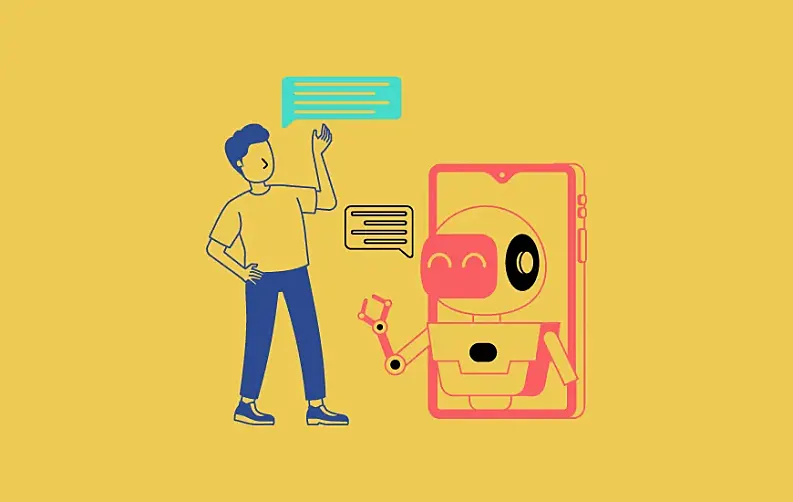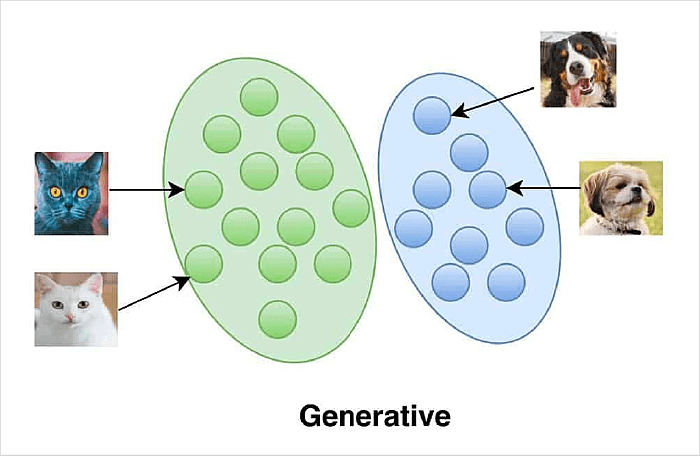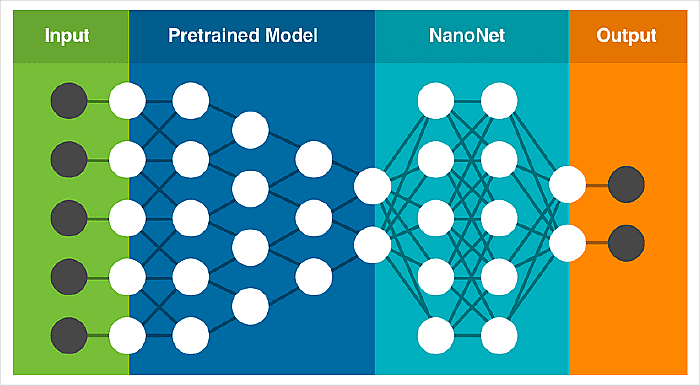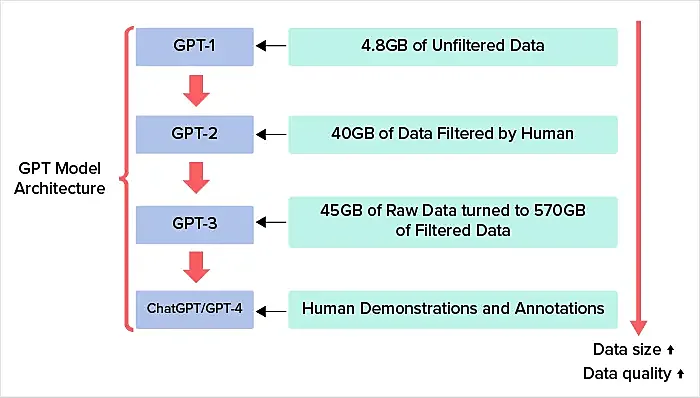
- Need of OpenAI GPT Model?
- What is OpenAI GPT Model?
- How does GPT Work?
-
How to Build an OpenAI GPT model?
- Collection of Data
- Preprocessing of Data
- Setup for Training the GPT Model
- Architecture of the Model
- Training of the GPT Model
- Fine-Tuning of the GPT Model
- In-domain fine-tuning
- Prompt Engineering
- Reinforcement Learning
- Few-Shot and One-Shot learning
- Evaluation of the GPT Model
- Deployment of OpenAI GPT Model
- Wrapping Up!

Post the inception of ChatGPT, the majority of tech entrepreneurs are loitering around questions like “How to create a GPT model?”, “How to build an OpenAI GPT model?”, etc. The reason behind this is simple, the OpenAI GPT model provides a human-like conversational tone. Also, it is a great add-on to any service making it capable of answering tonnes of user queries with ease.
In order to achieve this, every tech entrepreneur is required to have an answer for “How to build an OpenAI GPT model?”. Therefore, let’s start on our journey to help you build your own GPT-3 (the latest open-source GPT model) model.
However, before that let’s understand the need of having your own GPT model in brief!
Need of OpenAI GPT Model?
This entire charade of the tech community wants to learn “How to create GPT model?” started when ChatGPT came into existence. However, ChatGPT can’t be integrated into an app but the model on which it is based can. This compels the AI Chatbot companies to make use of OpenAI ChatGPT model that are GPT-1, GPT-2, and GPT-3.
Another reason to have your own GPT model is that every use case requires its own set of information that can often be unique to it. Therefore, a chatbot system is required to have all that unique data. Also, the existing GPT models are only trained with data up to September 2021.
Note: Want to learn about the cost to develop an app, click on the link provided.
What is OpenAI GPT Model?
In the abbreviation of GPT Model, GPT stands for Generative Pre-trained Transformer. What GPT model is? can easily be understood by simply understanding its full form.
To further extrapolate, here is information on what each of these words means:
Generative

Here the word generative describes the generative model i.e. a statistical model that works on the probability of p(X, Y). Here X is the instances of data and Y is the label associated with the data.
Note: For instance, if the data is “German Shepherd” then its label would be “Dog”.
Pre-trained

Here the meaning of Pre-trained is that the model has already been trained on a large set of data. Pre-trained models are not always accurate but are faster to implement.
Transformer
It is one of the most powerful models created in recent times. A transformer model works on the mathematical concept of attention or self-attention. It is essentially a neural network that learns contextual information and forms relationships between the data fed to it based on the sequence.
How does GPT Work?
The OpenAI GPT model is capable of language prediction with the help of technologies such as neural networks and machine learning. It takes input from one end and then transforms it into results based on the input.
The OpenAI GPT model has been trained on the technique known as Generative Pre-training. As per it, the OpenAI language model is first subjected to supervised learning to spot patterns. Later on, a team of trainers asks the model a question. Based on the correctness or incorrectness of the response, the trainer tweaks the answers. With this continuous feedback learning loop, the OpenAI GPT model was created.
Therefore anytime a user asks a question to ChatGPT, the GPT model responds with the best response possible.
Some amazing facts about the OpenAI GPT model:
- The ChatGPT OpenAI model has trained on various data sets using data from WebText2, Common Crawl, and Wikipedia
- The OpenAI GPT-3 model comprises more than 175 billion parameters of machine learning.
- The GPT 4 model has 47 gigabytes of training data while its predecessor had 17 gigabytes of data.
How to Build an OpenAI GPT model?
There are several steps involved with the development of the OpenAI language model. Therefore, let’s start learning about the process:
1. Collection of Data

Gathering a relevant dataset in order to train the model is an essential step to build your own GPT-3 for answering the question “How to build an OpenAI GPT model?”.
For instance, the amount of data gathered for each version of existing GPT models started from 4692.8 mb of raw test. However, the GPT-4 model utilized 45 Gigabytes to turn it into 570 Gigabytes of usable text. The data gathered should also cover a large range of topics to provide versatile answers to each of its users.
2. Preprocessing of Data
A majority of people don’t understand this but raw data text can’t be used for training a model. It is because these training sets are polluted with so many semicolons, bad writing, misspelled words, punctuations, etc. Therefore, it requires cleansing before feeding it to the model for training. If not done, those errors can easily be seen during the working of the model.
3. Setup for Training the GPT Model
In order to train an OpenAI language model, a proper setup is required in terms of both hardware and software.
To create an OpenAI language model, the hardware required would be:
- A high-end GPU or a cloud-based GPU in order to accelerate the training process
- RAM to handle the size of the model and data along with the exact requirement of the size of the model and dataset.
In terms of software requirements, the software and libraries that are required would be:
- Python: Python is an adequate language for developing AI-based technology. In fact, for this task, it is often the first choice of almost every developer. It is because it allows the installation of necessary libraries.
- Tensorflow or PyTorch: Both of these frameworks are machine learning training models that can be used to train new models.
- Transformers library: Using this library, the developers can get pre-trained GPT models and tools for training new models using PIP (Python installer package).
- Additional Libraries: The additional libraries used are required for specific purposes such as preprocessing of the data, visualization, or in case of evaluation.
4. Architecture of the Model
GPT hasn’t evolved to its current state in a day. It took it several years to reach here. Albeit this, there are several open-source architectures of GPT that are available for use. These are:
GPT-1: This was the first GPT model. It consisted of transformer-based architecture with a stack of transformer encoder layers. This GPT model was trained using unsupervised learning on a large volume of data to generate results.
GPT-2: GPT-2 was an upgrade to the success of GPT-1. It took a larger model set and an increase in the significant number of parameters. This GPT model utilized “masked language modeling” which allowed it randomly mask certain words and predict the missing ones.
GPT-3: With the GPT model, the corpus of data utilized was even larger making it much more powerful. This model introduced few-shot and one-shot learning. This enables the model to perform much better on tasks with only some examples. This is the latest open-source model that is available for modification.
Beyond these GPT architectures, there are two more i.e. GPT-3.5 and GPT-4. However, these are not open source, therefore, not available for modification. To answer “How to create GPT model?” choose the most appropriate GPT model, as per your requirements. Either you can modify it, or use it as it is based on the use case.
5. Training of the GPT Model
In this stage of OpenAI create model, the model is trained using preprocessed text data. To achieve this a training loop is created using the code to make it suitable for the existing use case. This is achieved using Adam Optimizer. It is a stochastic gradient descent method. This means the Adam Optimizer utilizes iterations to smoothen the data for training. It is done by replacing the existing data with an estimated current version of the data. This helps in removing all the unwanted redundancies in the data to make the training data much more lucrative for the process.
This section of the code defines the training loop for the GPT model. It uses the Adam optimizer to minimize the cross-entropy loss between the sequence’s predicted and actual next words. The model is trained on batches of data generated from the preprocessed text data.
6. Fine-Tuning of the GPT Model
It is essential to fine-tune the GPT model. Fine-tuning the model helps in helping the model predict that data with fewer adjustments and not too much contextual data. There are several methods that can be utilized to achieve this task. These methods are:
7. In-domain fine-tuning
In this type of fine-tuning, a pre-trained language model is refined to a specific dataset. This help in improving the model for the use case for which it is being developed. This also enables the model to learn the vocabulary and the patterns required for the task. There are several approaches to applying in-domain fine-tuning, however, one of the most common approaches is the masked language modeling (MLM) task. Other great approaches would be supervised learning. In this, the system is fed with labels of data and then later on asked to predict labels for new data.
Benefits of In-domain fine-tuning are:
- It has the capability to improve the existing performance of a pre-trained model
- This type of tuning can help with specific vocabulary and patterns associated with the use case
- It helps in generating responses that are much more relevant to the task.
Associated Challenges:
- It is a time-consuming process considering it requires the collection and labeling of data to train a particular dataset for a particular task.
- The model isn’t good with data generalization that isn’t from the same domain.
8. Prompt Engineering
This is another technique used by large language models (LLM). the idea behinf the technique is to improve the overall performance of these models. In this, a short piece of text is used to describe the LLM task to accomplish the task.
This technique can be used for multiple other purposes such as:
- Answering the Question
- Summarization of data
- Translation of data
- Creative writing
- Generation of code
9. Reinforcement Learning
This is another way to tune a model. Using reinforcement learning, the GPT model at hand is trained with learning techniques that are reward based. It's like giving a treat to a dog for the successful completion of a task or good behavior. This can be used for generating dialogues. The aim here is to create responses that are both engaging and informative in nature. This is done through a simulated environment via human evaluators.
10. Few-Shot and One-Shot learning
Both of these are machine learning techniques. These techniques allow GPT models to learn from small datasets of examples. In few-shot, the model is provided with a few examples to learn. Adding to it, in one-shot learning, there is only one example given to learn from.
Applying this can be tricky considering the fact that there are limited examples to learn from. However, its advantage is real-world applications where collecting data is an expensive process.
There are several approaches to apply these approaches such as:
- Meta-Learning
- Transfer Learning
- Data Augmentation
- Embedded-based Approach
- Generative Approach
11. Evaluation of the GPT Model
Evaluating a language model like GPT for its efficacy is important. Therefore, here are some of the methods that can be used for evaluating the GPT model. These are:
- Perplexity: In this method, the efficacy of the model to predict the next word in the language is tested. In this, a lower perplexity denotes the capability of the language model to predict the next word.
- BLEU: In this method, the generated and reference text are compared. Based on the comparison, a BLEU score is generated. If the BLEU score is high then the generated text is similar and vice versa.
- ROUGE: This one seems similar to BLEU considering it also utilizes generated and reference text. However, this method focuses on the overlap that happens between the generated text and the reference text.
- Human Evaluation: In this human operators are asked to rate the quality of the generated text.
12. Deployment of OpenAI GPT Model
In order to deploy a GPT model, its needs to have an API. This allows the app or service to send requests to APIs with the user input. It is also essential to choose a deployment platform based on the service. The service could be web-based, cloud-based, and even app based.
Once that is done, it is time to configure the deployment environment. This includes the process of handling the required dependencies and libraries that are required by the GPT model. Once everything is done, it is time to test and optimize the model that is created for a smooth experience. Once the final GPT model is ready, the team needs to continuously monitor the deployed app. Just in case, any issue arises, the dev team should immediately respond.
Wrapping Up!
Figuring out how to build an OpenAI GPT model is an important riddle for today’s companies. It is considering the fact that every company is pushing to engage their customers better. Every company is looking to increase their customer experience. For that, having an AI chatbot that can talk like a human and engage customers like a human is essential. With the article above, we have tried to provide a blueprint to get your own OpenAI GPT model. However, to turn that into reality, you’d require a team of developers and other resources to combine the power of OpenAI GPT into your existing system or service.
Frequently Asked Questions
-
How to create a model?
-
How to build a model?
-
How to build an AI model in Python?
-
How does GPT machine learning work?



















